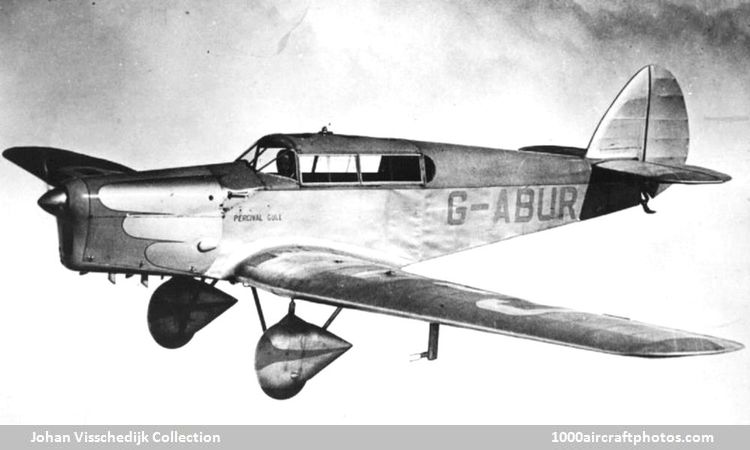05/31/2018. Remarks by Johan Visschedijk: "The history of the pictured aircraft is a bit sketchy. It was preceded the Hendy 302 tandem two-seat cabin monoplane designed by Basil Henderson and H.A. Miles of the Hendy Aircraft Company at Shoreham, UK. The well-known Edgar W. Percival participated in the project, Henderson and Miles doing the actual design work, calculations, etc., and Percival contributed practical advice out of his long and varied experience of aircraft. Reportedly he also contracted George Parnall & Co. Ltd. at Yate (near Bristol) to construct the Hendy 302, which became Percival's mount in the 1930 King's Cup race. Registered G-AAVT and powered by an 105 hp Cirrus Hermes I inverted four-cylinder air-cooled in-line engine, the aircraft received a CofA on June 27, 1930. In the King's Cup race it averaged a respectable 128.51 mph (206.82 kmh).
For the 1932 edition of the King's Cup, reportedly Percival himself designed a new type. However, before Henderson and Percival went their separate ways, Henderson reportedly had designed a three-seat version of the 302, known as the 301, and most likely this eventually became the Percival Gull. Although slightly larger in overall dimensions and different area sizes, the Gull had striking similarities with the 302. The Gull was constructed at the British Aircraft Company Ltd. at Maidstone. Fitted with an 130 hp Cirrus Hermes IV it was finished in late June 1932. Registered G-ABUR and under the race number 50, it was flown by Percival in the King's Cup race, which was held on July 8-9. The Gull had the highest average speed of 142.73 mph (236.94 kmh).
The aircraft had a forced landing in 1932 shortly after the Kings Cup and was nearly completely destroyed as shown by these photos. As of this date no crash details have been found, so a location and date are unknown. Since the Kings Cup race number 50 is on the wreckage, and the aircraft was reported at Croydon in the issue of Flight July 29, and the aircraft had been entered for the August 6 London to Newcastle race but did not participate, the crash most likely took place between July 28 and August 6, 1932. The aircraft next appeared in the Thanet race of September 18, 1932 and participated in meetings and races frequently, till the end of 1932.
It is suggested that the photo above shows the aircraft (with unbalanced rudder) during initial testing in late June, and subsequently was fitted with a balanced rudder. Again more likely, this is the aircraft after it was rebuilt after the crash, as from November 1932, the production aircraft also had an unbalanced rudder.
In the following year it was modified with a long greenhouse type canopy and was re-engined with a Napier Javelin III. With a top speed of 160 mph (257 kmh), it was superior to many contemporary fighters. With race number 40, it participated in the 1933 King's Cup race. Eventually G-ABUR was lost in Northern Rhodesia during Man Mohan Singh's 1935 Cape record attempt."
